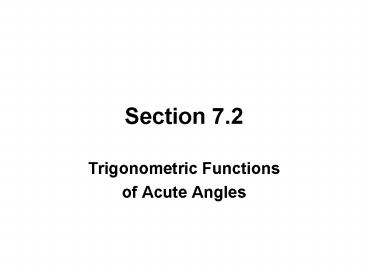Trigonometric Functions - PowerPoint PPT Presentation
1 / 13
Title:
Trigonometric Functions
Description:
Recall from geometry that similar triangles have angles of the same measure but ... side opposite to the angle, the side adjacent to the angle, and the hypotenuse. ... – PowerPoint PPT presentation
Number of Views:117
Avg rating:3.0/5.0
Title: Trigonometric Functions
1
Section 7.2
- Trigonometric Functions
- of Acute Angles
2
SIMILAR TRIANGLES
Recall from geometry that similar triangles have
angles of the same measure but the lengths of
slides are different. An important property of
similar triangles is that the ratios of the
corresponding sides are equal.
That is,
3
RIGHT TRIANGLES
For right triangles, we give these ratios the
names sine, cosine, tangent, cosecant, secant,
and cotangent.
4
RIGHT TRIANGLES (CONTINUED)
These are usually given in terms of the side
opposite to the angle, the side adjacent to the
angle, and the hypotenuse.
5
FUNDAMENTAL IDENTITIES RECIPROCAL IDENTITIES
6
FUNDAMENTAL IDENTITIES QUOTIENT IDENTITIES
7
FUNDAMENTAL IDENTITIESPYTHAGOREAN IDENTITIES
8
FINDING VALUES OF TRIG. FUNCTIONS WHEN ONE IS
KNOWN
Method 1 Using the Definitions
Step 1 Draw a right triangle showing the acute
angle ?. Step 2 Two sides of the triangle can be
assigned values based on the given trigonometric
function. Step 3 Find the length of the third
side using the Pythagorean Theorem. Step 4 Use
the definitions of the trigonometric functions to
find the value of the remaining trigonometric
functions.
9
FINDING VALUES OF TRIG. FUNCTIONS WHEN ONE IS
KNOWN
Method 2 Using Identities Use appropriately
selected identities to find the value of each of
the remaining trigonometric functions.
10
COMPLEMENTARY ANGLES
Two acute angles are called complementary if
their sum is a right angle. Since the sum of the
angles in any triangle is 180, in any right
triangle the two acute angles are complementary.
11
COMPLEMENTARY ANGLES AND TRIGONOMETRIC FUNCTIONS
Theorem Cofunctions of complementary angles are
equal.
12
COFUNCTION IDENTITESIN DEGREES
13
COFUNCTION IDENTITESIN RADIANS































